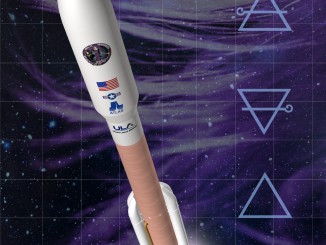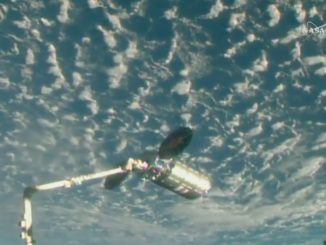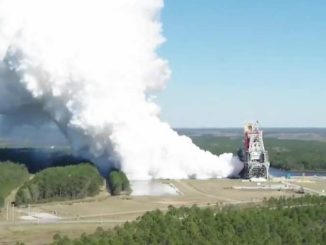
United Launch Alliance has completed stacking of the major elements of the Atlas 5 rocket assigned to power NASA’s Perseverance rover toward Mars, but the mission’s launch date has been pushed back three days to July 20 after teams repaired an issue with a crane in the Atlas 5’s assembly building.
NASA said ULA needed the extra time to repair an issue with ground system equipment associated with the Atlas 5 rocket.
Tory Bruno, ULA’s president and CEO, wrote on Twitter that the issue was a “controller fault” on a crane at Cape Canaveral. ULA uses a crane to hoist rocket components inside the Atlas 5’s Vertical Integration Facility, located a quarter-mile south of the Atlas 5’s seaside launch pad at Complex 41.
The launch of NASA’s Perseverance Mars rover was previously scheduled for July 17, the opening of a 26-day launch window to enable the robotic spacecraft to travel directly on a seven-month journey from Earth to Mars. NASA and ULA recently assessed the performance of the Atlas 5 rocket and the final mass of the spacecraft, engineers determined they could add six days to the launch period to close Aug. 11.
“We’re moving the launch over by three days to the 20th,” said Thomas Zurbuchen, associate administrator of NASA’s science mission directorate. “We, of course, have a long window ahead of us.”
There’s a two-hour launch window available July 20 opening at 9:15 a.m. EDT (1315 GMT), according to NASA.
If the Perseverance mission misses its launch opportunity this year, the next chance to launch the mission won’t come until 2022. NASA prioritized the continuation of launch preparations for the Perseverance rover amid the coronavirus pandemic, even as other missions faced delays.
The agency says a two-year delay in the rover’s launch would add some $500 million to the mission’s cost, which is already more than $2 billion.

Stacking of the Atlas 5 rocket — tail number AV-088 — began May 28 with the hoisting of the first stage vertical on top of the Atlas mobile launch platform inside the VIF.
The Atlas 5 for the Perseverance rover mission will fly in the “541” configuration with four strap-on solid rocket boosters and a 17.7-foot-diameter (5.4-meter) diameter payload fairing. It’s the same Atlas 5 configuration used to launch the Curiosity rover in 2011.
The Perseverance rover is based on the Curiosity design, but it features several technology upgrades and a new suite of scientific instruments. One of the prime goals of the Perseverance mission is the collection of rock core samples inside small cigar-shaped tubes for retrieval by a future rover for return to Earth.
ULA completed stacking of the four solid-fueled boosters after raising the first stage inside the rocket’s vertical hangar. The solid-fueled motors, already packed with propellant, were manufactured by Aerojet Rocketdyne.
The Atlas 5’s Centaur upper stage, which will propel the rover on an escape trajectory away from Earth, was stacked on top of the rocket Wednesday, June 10. The Centaur stage, with a single Aerojet Rocketdyne RL10 engine, was integrated with the Atlas 5’s interstage adapter and the lower half of the rocket’s payload fairing in a nearby processing facility at Cape Canaveral before its move to the VIF this week.

ULA will roll the Atlas 5 rocket out to pad 41 later this month for a fueling test. ULA performs such fueling demonstrations before launches with limited planetary launch windows to ensure teams can detect and resolve any problems one the rocket before launch day.
The Atlas 5 will return to the VIF after the tanking test for attachment of the Perseverance rover, which will be encapsulated inside the Atlas 5’s payload shroud in the coming weeks inside the Payload Hazardous Servicing Facility clean room at the Kennedy Space Center.
The Multi-Mission Radioisotope Thermoelectric Generator, or MMRTG, is the rover’s nuclear power source. It will be connected with the rover once the spacecraft is already mounted on top of the Atlas 5 launcher inside the VIF.
The MMRTG converts heat from the radioactive decay of plutonium into electricity. Provided by the U.S. Department of Energy, the power generator is one of the final items installed on the rover in the final weeks before launch.
The Atlas 5 rocket is the only launch vehicle currently certified by NASA to carry nuclear-powered payloads into space.
After launching this summer, the Perseverance rover is scheduled to land Feb. 18, 2021, on Mars in a region named Jezero crater, the site of a dried-up river delta where scientists hope to find signatures of ancient life.
Email the author.
Follow Stephen Clark on Twitter: @StephenClark1.



